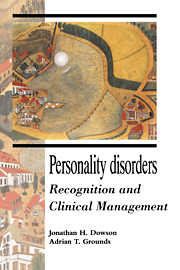Book contents
- Frontmatter
- Contents
- Acknowledgement
- Part One Recognition
- 1 Personality disorders: basic concepts and clinical overview
- 2 Specified personality disorders: clinical features
- 3 Personality disorders: less specific clinical presentations and epidemiology
- 4 Longitudinal aspects of personality disorders
- 5 Assessment of personality disorders
- Part two Clinical management
- References
- Index
3 - Personality disorders: less specific clinical presentations and epidemiology
from Part One - Recognition
Published online by Cambridge University Press: 19 October 2009
- Frontmatter
- Contents
- Acknowledgement
- Part One Recognition
- 1 Personality disorders: basic concepts and clinical overview
- 2 Specified personality disorders: clinical features
- 3 Personality disorders: less specific clinical presentations and epidemiology
- 4 Longitudinal aspects of personality disorders
- 5 Assessment of personality disorders
- Part two Clinical management
- References
- Index
Summary
Personality disorder not otherwise specified (DSM-III-R and DSM IV) or mixed and other personality disorders (ICD-10)
Main features and definitions
The DSM-III-R and DSM-IV category of ‘personality disorder – not otherwise specified’ refers to any disorder of personality that cannot be classified as one or more specific PDs, for example, features of one or more PDs that do not meet the full criteria for any one PD, yet cause significant impairment in social or occupational functioning, or subjective distress.
The ICD-10 category ‘mixed and other personality disorders’ is similar but also includes the disorders of patients who have several PDs but without a predominant set of symptoms. The latter would be expected to be the most prevalent PD diagnosis in psychiatric practice, as many studies have shown frequent co-occurrence of two or more PDs in various patient populations.
Clinical features
Most studies of PDs have found that at least 50% of patients with PD had two or more PDs (Oldham et al., 1992); for instance Nurnberg et al. (1991) found 82% of patients with borderline PD had at least one additional PD diagnosis from another DSM-III-R PD cluster. Although the term ‘co-morbidity’ has generally been used to denote co-existing disorders that have distinct causes, the term ‘co-occurrence’ is more appropriate in relation to PDs, as it does not have any aetiological implications.
- Type
- Chapter
- Information
- Personality DisordersRecognition and Clinical Management, pp. 128 - 158Publisher: Cambridge University PressPrint publication year: 1995
- 1
- Cited by



